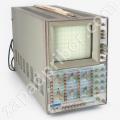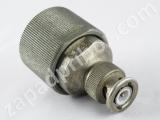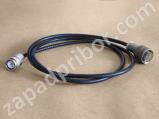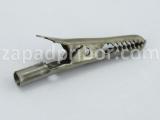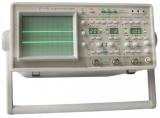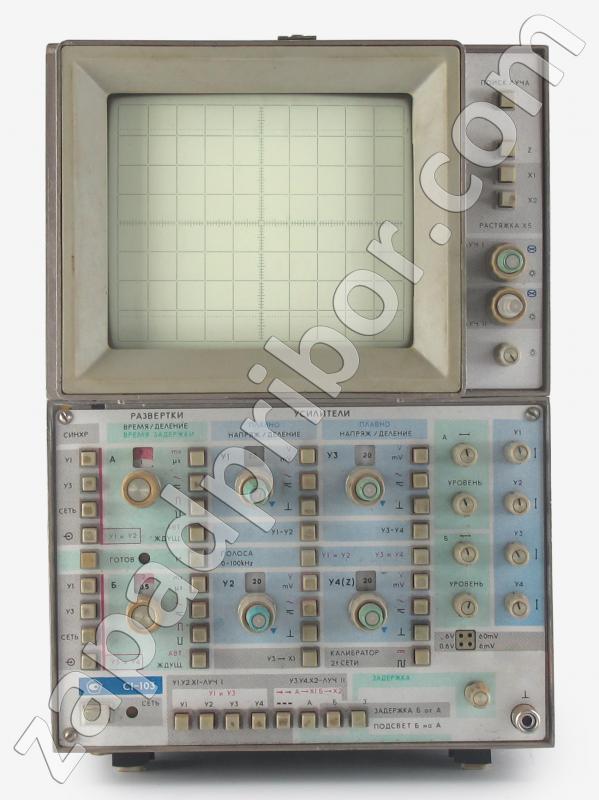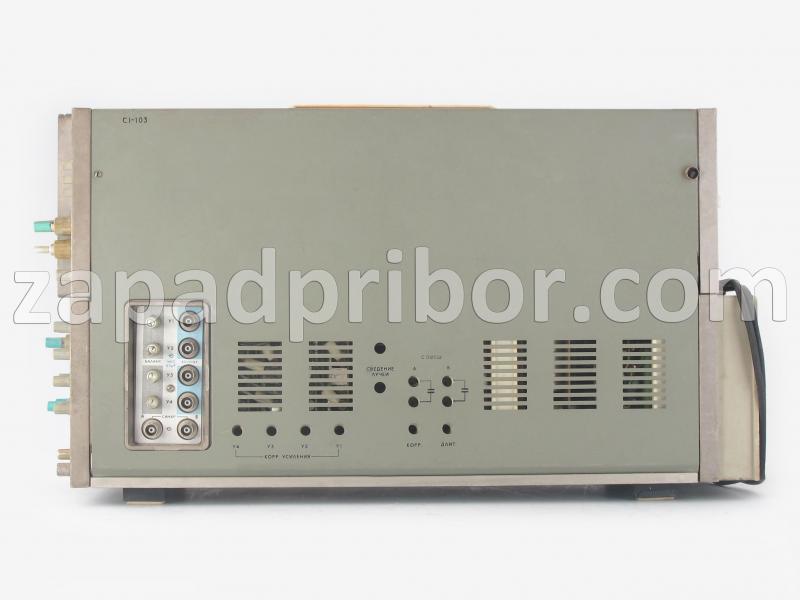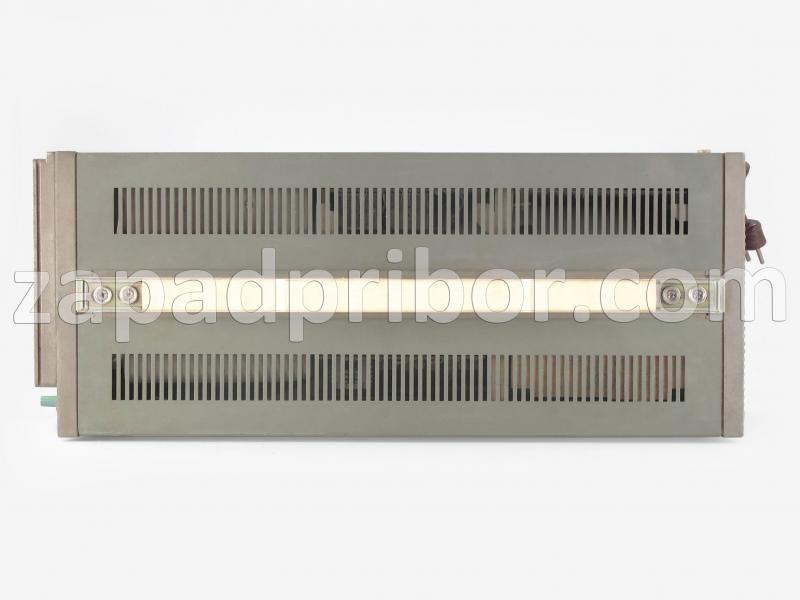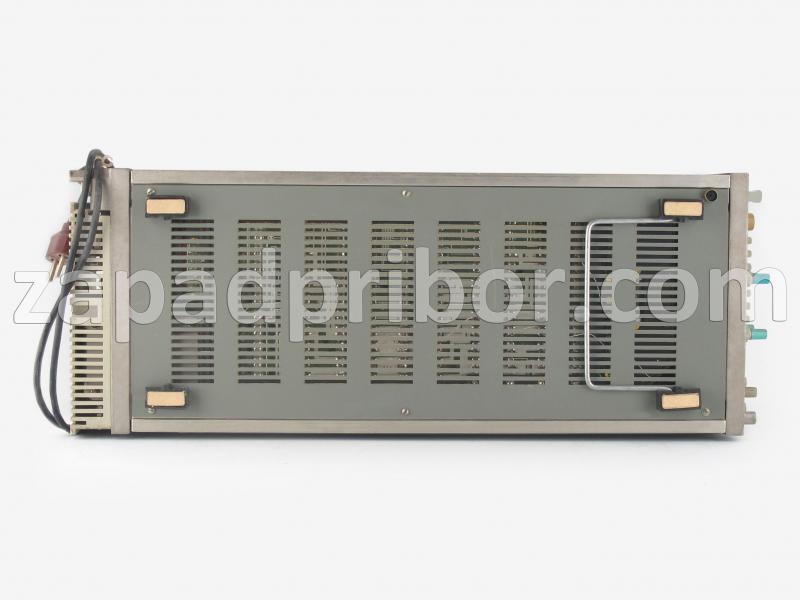Products catalog
Price:
on request
Product information updated 15 April 2024.
Found cheaper?
Let us know. Our price is the best.
Warranty:
12 months.
Warranty extension up to 5 years.
Terms of delivery:
To all regions of the country, international delivery.
Product information updated 15 April 2024.
Found cheaper?
Let us know. Our price is the best.
Warranty:
12 months.
Warranty extension up to 5 years.
Terms of delivery:
To all regions of the country, international delivery.
Technical characteristics
Four-channel oscilloscope is a dual-beam S1-103
Also, this device may be referred to: S1103, S1 103, c1-103, c1103, c1 103.
S1-103 four-channel oscilloscope is a dual-beam shape is used for the investigation and measurement by visual observation and photographing of one to four and one-time periodic signals to be displayed in one or two time scales, the value of 0,2·10-3 V to 250 V and a duration of 0,4·10-6 s to 5 s, and for comparing the measure from two to four signals.
Application: for electric and radio measurements in various fields of science and technology from the research and test work in laboratory and industrial conditions.
Specifications S1-103:
Accuracy class - 2.
Amplifier channels oscilloscopes - 4 (2 per beam).
Generators scans - 2.
Effective screen - 120×100 mm.
Basic error - ±4%.
Maximum measured error rectangular pulses:
- amplitude - ±(5+(0,015·10-3 V/Ux)·100)%, where Ux - signal voltage in volts;
- duration - ±4%.
The line width of each beam - no more than 1 mm.
Observed pulses S1-103:
- duration of fronts - from 100 ns to 170 ns;
- repetition rate - not less than 1100 Hz.
Coefficient of variation of channels - from 0,05 mV/div to 20 V/div (steps accordingly series of numbers 1, 2, 5).
The maximum amplitude of the signals:
- direct access - 80 V;
- external divider 1:10 - 250 V.
Surge characteristic
Rise time:
- at a rate of deviation of 0,5 mV/div (direct input and external divider transmission factor 1:10) - not more than 35 ns;
- when working with external divider with 1:1 gear ratio - no more than 70 ns;
- i the coefficient of variation of 0,05 mV/div, 0,1 mV/div, 0,2 mV/div - no more than 350 ns;
- switch in the on position THE BAND from 0 kHz to 100 kHz - not more than 3,5 ms.
Emissions and uneven S1-103:
- with direct input - no more than ±5%;
- coefficient of variation at 5 V/div to 20 V/div (working conditions of application) - not more than 10%.
Settling time:
- at a rate of deviation of 0,5 mV/div (direct input and external divider transmission factor 1:10) - not more than 150 ns;
- when working with external divider with 1:1 gear ratio - less than 300 ns;
- if the coefficient of variation of 0,05 mV/div, 0,1 mV/div, 0,2 mV/div - less than 1 ms;
- switch in the on position THE BAND from 0 kHz to 100 kHz - no more than 10 ms.
Uneven tops - no more than 2%.
Recession tops for 1 ms with the entrances closed - no more than 5%.
The drift of convergence at the screen S1-103:
- long-term drift (after 1 hour warm-up) - not more than 0,4 mV;
- short-term drift (with a coefficient of deviation of 0,05 mV/div) - no more than 50 mV.
Offset ray oscilloscope:
- when the voltage supply by 10% (15 min) - not more than 0,2 mV;
- at an input current to a load of 50±5 Ohm at a rate of deviation of 0,05 mV/div (when switching deflection factors) - no more than one business.
Deviations in the coefficient of variation of 0,05 mV/div:
- bandwidth from 0 MHz to 1 MHz - 0,05 mV;
- bandwidth from 0 kHz to 100 kHz - 0,02 mV.
Input resistance vertical deflection channels:
- with direct input - 1±0,03 MOhm;
- with external divider transfer coefficient at 1:10 - 10+0,5 MOhm;
- with external divider at 1:1 ratio transmission - 1±0,03 MOhm.
Capacity channel inputs vertical deflection:
- with direct input - 60±6 pF;
- with external divider transfer coefficient at 1:10 - no more than 20 pF;
- with external divider at 1:1 ratio transmission - 100±10 pF.
The total value of DC and AC voltages with the entrances closed - not less than 80 V.
Coefficient of isolation between amplifier channels S1-103:
- from 0 MHz to 3,3 MHz - not less than 10000;
- from 3,3 MHz to 10 MHz - not less than 5000.
The phase difference between the channels of the vertical and horizontal deflection device oscilloscopes in the frequency band from 0 kHz to 20 kHz - less than 3°.
Common mode rejection ratio signals - at least 500.
Common mode voltage - 0,5 V
Coefficient isolation between switched channels in a range from 0 MHz to 3,3 MHz - not less than 40.
The coefficients A and B scans
Setting:
- norm - steps from 0,1 ms/div to 0,5 s/div (or series of numbers 1, 2, 5);
- with external power capacitors - to 5 s/div (or series of numbers 1, 2, 5).
The presence of a single stretch 5 sweeps.
Basic error:
- from 0,1 ms/div to 0,5 s/div - no more than 4%;
- from 40 ns/div - not more than 10%;
- when using a bank of capacitors - no more than 5%.
The error in the operating conditions of use:
- from 0,1 ms/div to 0,5 s/div - not more than 6%;
- with coefficients of scans 1 s/div, 2 s/div, 5 s/div - not more than 7%.
B sweep delay with respect to the A sweep - from 1 ms to 50 ms.
Instability delay (from 3 ms to 50 ms) - not more than 1%.
Asynchrony scans rays I and II S1-103 - not more than 0,2 cases.
Bandwidth tract - 0 MHz to 1 MHz.
Internal synchronization:
Frequency range S1-103 with the coefficient of variation of 0,5 mV/div - from 20 Hz to 10 MHz.
Minimum levels - no more than (0,8+0,15·10-3 V/K) cases where
K - coefficient of variation:
- in the frequency range from 20 Hz to 2 MHz, the coefficient of variation of 0,5 mV/div;
- in the frequency range from 20 Hz to 1 MHz, with the coefficient of variation of 0,1 mV/div;
- in the frequency range from 20 Hz to 100 kHz, while the coefficient of variation of 0,05 mV/div and restriction bands from 0 kHz to 100 kHz.
The lower limit of the frequency range at the gated entrance sync - no more than 200 Hz.
Maximum levels of synchronization of the oscilloscope - at least 8 cases.
Instability sync - no more than 8 ns.
Moving image signal horizontally due to deviations - no more than (0,05·10-3 V/K) cases where
K - coefficient of variation.
External synchronization S1-103
Frequency harmonic voltages:
- an open synchronization input - from 20 Hz to 10 MHz;
- closed sync input - from 200 Hz to 10 MHz.
Duration of pulse signals - from 100 ns.
Amplitude of the signal oscilloscopes:
- minimum - not more than 0,5;
- max - not less than 10.
Instability synchronization S1-103 - less than 15 ns.
Synchronization input scans A and B:
- input resistance - not less than 100 Ohm;
- input capacity - not more than 60 pF.
Built-in calibrator
Pulse shape - rectangular.
The magnitude of the calibration signals S1-103 - 6V, 0,6V, 60 mV, 6 mV.
Error voltage calibrator oscilloscope:
- normal conditions - no more than ±1%;
- working conditions for the application, with a load of not less than 0,5 MOhm - ±1,5%.
Brightness modulation rays positive signal:
- the amplitude of - from 10 mV to 10 V;
- frequency range - from 0 kHz to 100 kHz.
Electrical safety:
Insulation strength of the mains power supply - 1,5 kV.
The insulation resistance between the circuit and the mains protective earth terminal:
- normal conditions - not less than 20 MOhm;
- fever - not less than 5 MOhm;
- after 2 days after the exposure chamber with a relative humidity (at a temperature of 30º C) from 91% to 95% - less than 2 MOhm;
- after 4 days after exposure in a chamber with a relative humidity of 95% (at 30º C) - 1 MOhm.
The resistance value of S1-103 - less than 0,5 Ohm.
Modes scans - autooscillation, waiting, single.
Time samoprogreva oscilloscopes - 15 min.
Dimensions - 541×200×304 mm.
Weight - no more than 17 kg.
Operating conditions S1-103:
Ambient temperature
- operating - from 5° C to 40° C (278 K to 313 K);
- limit - from -50° C to +60° C (223 K to 333 K).
Relative humidity at 30° C (303 K) - 95%.
Mains voltage - 220±22 V.
Frequency - 50±0,5 Hz and 60±0,6 Hz.
Harmonic S1-103 - 5%.
Power consumption - no more than 130·A.
Continuous operation oscilloscopes - 8 hours.
Voltage industrial radio:
- from 0,15 MHz to 0,5 MHz - no more than 80 dB;
- from 0,5 MHz to 2,5 MHz - 74 dB;
- from 2,5 MHz to 30 MHz - 66 dB.
RFI field strength:
- from 0,15 MHz to 0,5 MHz - no more than 60 dB;
- from 0,5 MHz to 2,5 MHz - no more than 54 dB;
- from 2,5 MHz to 300 MHz - no more than 46 dB.
MTBF device S1-103 - not less than 1000 hours.
Average life - 10 years.
Average life - 10000 hours.
Shelf life - 10 years.
Leading online store Zapadpribor - a huge selection of measuring equipment for the best value and quality. So you can buy inexpensive devices, we monitor competitors' prices and are always ready to offer a lower price. We only sell quality products at the best prices. On our site you can buy cheaply as the latest innovations and proven equipment from the best manufacturers.
The site includes a special offer «buy at the best price» - if other Internet resources (bulletin board, forum or announcement of another online service) in products presented on our site, the lower price, we will sell it to you even cheaper! Buyers also additional discount for leaving a review or photo of use of our products.
In the price list contains not the whole range of products offered. Prices of goods, not included in the price list can learn to contact the manager. Also, our managers You can get detailed information about how cheap and profitable to buy instrumentation wholesale and retail. Telephone and e-mail for advice on the purchase , delivery or receipt are shown on the description of the goods. We have the most qualified staff, quality equipment and the best price.
Online store Zapadpribor - the official manufacturer's dealer test equipment. Our goal - selling high quality goods with best price offer and service to our customers. Our store can not only sell you the necessary instrument, but also offer additional services to its calibration, repair and installation. That you have a pleasant experience when shopping on our site, we have provided special gifts guaranteed to the most popular products.
We offer fast international shipping to almost every country in the world: Australia, Austria, Azerbaijan, Albania, Algeria, Anguilla, Angola, Antigua and Barbuda, Argentina, Aruba, Bahamas, Bangladesh, Barbados, Bahrain, Belize, Belgium, Benin, Bermuda, Bulgaria, Bolivia, Bonaire, Sint-E. and Saba, Bosnia and Herzegovina, Botswana, Brazil, British Virgin Islands, Brunei Darussalam, Burkina Faso, Burundi, Bhutan, VietNam, Vanuatu, Vatican City, Venezuela, Armenia, Gabon, Guyana, Haiti, Gamia, Gambia, Ghana, Guatemala, Guinea, Gibraltar, Honduras, Hong Kong, Grenada, Greenland, Greece, Georgia, Denmark, Democratic Republic of the Congo, Jersey, Djibouti, Dominica, Dominican Republic, Ecuador, Eswatine, Estonia, Ethiopia, Egypt, Zambia, Zimbabwe, Jordan Indonesia, Ireland, Iceland, Spain, Italy, Cape Verde, Kazakhstan, Cayman Islands, Cambodia, Cameroon, Canada, Qatar, Kenya, Kyrgyzstan, China, Cyprus, Kiribati, Colombia, Comoros, Congo, Korea (Rep.), Costa Rica, Kot-d'Ivoire, Cuba, Kuwait, Curacao, Laos, Latvia, Lesotho, Lithuania, Liberia, Lebanon, Libya, Liechtenstein, Luxembourg, Myanmar, Mauritius, Mauritania, Madagascar, Macao, Malawi, Malaysia, Mali, Maldives, Malta, Morocco, Mexico, Mozambique, Moldova, Monaco, Monaco, Namibia, Nauru, Nepal, Niger, Nigeria, Netherlands, Germany, New Zealand, New Caledonia, Norway, UAE, Oman, Cook Islands, Pakistan, Palestine, Panama, Papua New Guinea, Paraguay, Peru, South Africa, Poland, Portugal, Republic of Chad, Rwanda, Romania, El Salvador, Samoa, San Marino, Saudi Arabia, Swaziland, Seychelles, Senegal, Saint Vincent and the Grenadines, Saint Kitts and Nevis, Saint Lucia, Serbia, Singapore, Sint Maarten, Slovakia, Slovenia, Solomon Islands, United Kingdom of Great Britain and Northern Ireland, Sudan, Suriname, East Timor (Timor-Leste), USA, Sierra Leone, Tajikistan, Taiwan, Thailand, Tanzania (United Republic of), Togo, Tonga, Trinidad and Tobago, Tuvalu, Tunisia, Turkey, Turkmenistan, Uganda, Hungary, Uzbekistan, Uruguay, Faroe Islands, Fiji, Philippines, Finland, France, French Polynesia, Croatia, Central African Republic, Czech Republic, Chile, Montenegro, Switzerland, Sweden, Sri Lanka, Jamaica, Japan.
We also provide such metrological procedure: calibration, tare, graduated, testing of measuring instruments.
The online store takes an active part in such procedures as electronic bidding, tender, auction.
If there is no site in the descriptive information you need on the device you can always turn to us for help. Our qualified managers will update for you on the technical characteristics of the device from its technical documentation: user manual, certificate, form, operating instructions, diagram. If necessary, we will take a photo of your device, or a device stand. You can leave feedback on the unit purchased from us, the meter, the device, indicator, or product. Your review for your approval will be published on the site without contact information.
Description of the instruments taken from the technical documentation or technical literature. Most pictures of products made directly by our experts prior to shipment of goods. In the description of the device provided the main technical characteristics of the instrument: nominal measuring range, accuracy class, scale, supply voltage, size (size), weight. If the site you see the discrepancy device name (model) specifications, photo or documents attached - let us know - you will get a useful gift with-selling device.
While the need to clarify the overall weight and size or the size of the individual meter you can in our service center. If you need our engineers will help you choose the most complete analog or a suitable replacement for the device you are interested. All counterparts and replacement will be tested in one of our laboratories with the full compliance to your requirements.
In the technical documentation for each device or product, information is provided on the list and amount of precious metals content. The documentation gives the exact weight in grams of precious metals: Au gold, palladium Pd, platinum Pt, silver Ag, tantalum Ta and other platinum group metals (PGM) per unit item. These precious metals are found in nature in very limited quantities and therefore have such a high price.
On our website you can familiarize yourself with the technical characteristics of devices and obtain information on the content of precious metals in devices and radio components manufactured in the USSR. We draw your attention to the fact that often the actual content of precious metals differs by 10-25% from the reference one in a smaller direction! The price of precious metals will depend on their value and mass in grams.
All text and graphic information on the site is informative. The color, shade, material, geometric dimensions, weight, content, delivery set and other parameters of the goods presented on the site may vary depending on the batch of production and year of manufacture. Check with the sales department for more information.
If you can make repairs to the device yourself, our engineers can provide you with a complete set of necessary technical documentation: circuit diagram TO, ER, FD, PS. We also have an extensive database of technical and metrological documents: technical specifications (TS), the terms of reference (TOR), GOST (DSTU), the industry standard (OST) test procedure, the method of certification, verification scheme for more than 3,500 types of measuring equipment from the manufacturer this equipment. From the site you can download all the necessary software (the software driver) is required for the product purchased.
We carries out repairs and maintenance of measuring equipment in more than 75 different factories of the former Soviet Union and CIS.
We also have a library of legal documents that are related to our field of activity: the law, code, ordinance, decree, temporary position.
